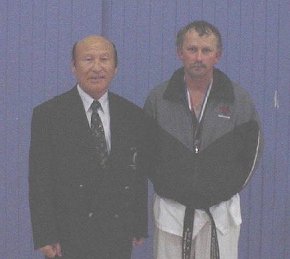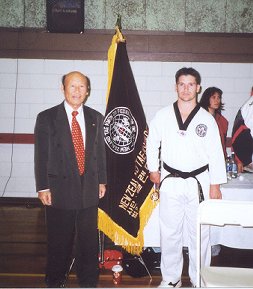

GM Lee's training was based first and foremost on self-defence. The training was hard in the thin mountain air and also dangerous. This was tiger country, there were no roads, and only narrow walking tracks and the countryside was infested with snakes and wild dogs. The inherent danger of this environment served to sharpen GM Lee's senses and skills, and he became very proficient at his martial arts training. The original style GM Lee was trained in was Bong Hwa Kwan, one of the several styles that evolved into Taekwondo as we know it today.
GM Lee won a technical scholarship at high school and went on to study at Chosun university, majoring in physical education. After graduating he set up his own dojang in Kyangju City. At this time not many people studied the martial arts in Korea because the Japanese had occupied Korea since1907, and had forbidden the study of Korean martial arts. When the Japanese occupation ended in 1945 the few Koreans who were experienced in their traditional martial arts by studying in secret, began the long and arduous task of re-establishing the arts in the Korean culture. GM Lee was one of these people.
Shortly afterwards, GM Lee became eligible for his stint of compulsory Army service. He signed up as an officer and began with a one year course at the Army's training academy in 1959. Graduating with the rank of first lieutenant he went on to begin another 12 month course - this time training as a commando in the special forces. Needless to say, the training involved in becoming a Special Forces Commando was extremely tough. Every week the trainees would be tested and any that did not pass were taken off the course and put back into the regular Army. Out of 800 trainees at the beginning of each course, only 12 would pass on average. As part of the course, sometimes the trainees would have to go without food for a week, and other times living off the eating tree roots, catching birds, or whatever was necessary survive. GM Lee explains that after a week without food the sense of smell becomes very acute. They would be tested on this by being placed two miles downwind from a village and told to record everything that happened during a day - such things as when the cooking was done, what was cooked, when toilets were used, if women wore perfume, and so on.
GM Lee not only passed, but excelled in his Special Forces training to the point where his superiors made him an Instructor and put him in charge of a large section of the Demilitarised Zone between North and South Korea. While their relationship with the North Koreans was outwardly friendly during the daytime his unit would often across into the North at night and occasionally be called upon to undertake covert assignments such as infiltrating North Korea to gather intelligence. Often he would have to agents safely up to 30 km behind enemy lines, overcoming booby traps, mines, guards, and patrols in the process.

Sometimes GM Lee would be involved in testing the skills and abilities in various ways. At one time the Army was put on alert that there was a dangerous North Korean spy in Seoul. They were given a description and photographs of the spy and told to capture or kill. The "spy" was in fact GM Lee. Only his superiors and himself knew it was an exercise. He survived the manhunt unscathed.
Because of his skill and diligence in training others GM Lee earned a great deal of respect from people all ranks within the South Korean army. When the Vietnam War broke out South Korea assisted South Vietnam and ultimately GM Lee was sent to Vietnam in 1966 train their commandos. He held positions of Director of Education and Technical Director of Vietnam Taekwondo Federation. During the Vietnam war many Taekwondo instructors were to Vietnam from Korea and it compulsory that they passed a month training course with GM Lee before they could begin teaching the Vietnamese.
Because of GM Lee's importance to the Vietnamese he was assigned two bodyguards and two drivers and had at least three places to stay: a house on the base, another in the city, and a selection of hotels. Not until the end of each day would he select a driver and bodyguard and select where he would stay that evening.
During his time in Vietnam GM Lee became well known his martial arts skills and received an invitation from Thailand to send a team to compete against a team of Thai kickboxers. GM Lee trained his team 10 hours a day, every day, for two months for the event. On their way to Thailand they put on a demonstration in Kuala Lumpar and upon arriving in Thailand they were asked to perform a similar demonstration. The evening before the competition they performed their demonstration in front of a crowd of 10,000 people. They broke boards and tiles, and showed combat and fighting techniques with such ferocity and determination that later that evening the organisers of the competition cancelled the fights due the next day.
During his time in Vietnam GM Lee was awarded the Education Medal from the South Vietnamese government for his services and later was awarded the In Han Medal and Bronze Star Medal in recognition of his services to Korea.
GM Lee left the Korean army in 1971 with the rank of captain (special forces) and took up the position of Director of the Bong Hwa Taekwondo Hapkido Gymnasium in Seoul, Korea. As one of the many people involved in establishing the World Taekwondo Federation internationally he would travel to many countries for this purpose, staying sometimes for several months at a time. From his time in the army GM Lee developed quite a reputation for himself, particularly among many of the Americans who had been stationed in Vietnam. When he left the army the American Taekwondo Association invited GM Lee to the USA and provided a work visa so that he could teach martial arts. However, at the time, GM Lee personally knew the New Zealand ambassador in South Korea and had heard a lot about New Zealand from knowing several kiwis in Vietnam.
GM Lee considered the opportunities both in New Zealand and in the USA and ultimately decided to move to New Zealand. There were many reasons: many of GM Lee’s former American students in Vietnam had set up Taekwondo schools in America, and Lee did not feel it was appropriate for him to set up schools in competition to students who were diligently promoting Taekwondo. In addition, New Zealand represented a great opportunity to establish and develop Taekwondo in a new country. This "challenge" and the prospect of raising his family in a country with a clean healthy reputation far outweighed the greater financial rewards available in the USA.
With his decision made GM Lee arrived in New Zealand in 1975 and began teaching Taekwondo. He started at the YMCA in Wellington with seven people and soon expanded by running special courses for the police, traffic officers, army, airforce, prison officers, and women’s groups. For the first two years GM Lee devoted all his time to establishing Taekwondo while his wife and three children stayed in Korea with relatives.
GM Lee founded the New Zealand Taekwondo Federation and it did not take long for him to establish new clubs by helping his senior students to become instructors. GM Lee spent the first five years concentrating his efforts and establishing Taekwondo clubs around Wellington and the lower North Island before expanding to the Taranaki area. He founded the New Plymouth Taekwondo club in 1981 and soon established other clubs in the area.
In 1983 came the first club in Auckland at the Auckland Technical Institute and it was not long before there were federation clubs throughout NZ. GM Lee would travel extensively, sometimes driving for five hours, teaching at one club from 5.30 to 7, another from 7.30 to 9, and then driving another five hours home. In 1991 GM Lee moved from Wellington to Auckland to concentrate his efforts in promoting Taekwondo to a larger population base.
During his time in NZ GM Lee has also worked on extending his own qualifications, going from 6th Dan black belt when he arrived, to 9th Dan and the title of Grandmaster which he graded for in 1991. He explains that the higher dan gradings are not just physical tests but involve a great deal of written work - similar to a university degree. His last grading, for 9th Dan, involved what amounted to a thesis on various counter attack techniques against other martial art styles such as kung-fu and karate, training techniques, and training equipment that maximise performance and remove the risk of injury.
Grandmaster Lee’s goals are to continue developing Taekwondo and the NZ Taekwondo Federation over the next few years, and then to select trustworthy people within the federation that he can pass all his knowledge and skill to, so that he can step back and take more of an advisory role. GM Lee says that the NZ Taekwondo Federation, like the World Taekwondo Federation, has always had its doors open to other Taekwondo and martial art groups, and he looks forward to the day when all such groups can be united in their promotion and development of Taekwondo.
